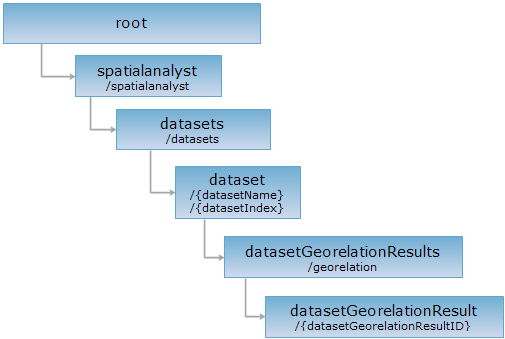
<datasetGeorelationResults_uri>/{datasetGeorelationResultID}[.<format>]
Geographic relation analysis result resource.
Supported Methods:
Supported output formats: rjson, json, xml.

Implement the HTTP request on the following URI, where supermapiserver is the server name, with rjson being the output format.
http://supermapiserver:8090/iserver/services/spatialanalyst-changchun/restjsr/spatialanalyst/datasets/BusLine@Changchun/georelation/xqzxg79p_ce128f528e0a4a0fbd2afba79780ee04.rjson
Get the result of the geographic relation analysis.
The response result is the geographic relation result array of the source dataset and the reference dataset, the type is GeoRelationResult<T>.
The following RJSON format is returned after a GET request is performed on the resource:
[{
"result": [59, 10],
"count": 2,
"source": 1
},
{
"result": [59, 10],
"count": 2,
"source": 2
},
{
"result": [60, 10, 59, 39],
"count": 4,
"source": 3
},
{
"result": [39],
"count": 1,
"source": 4
},
{
"result": [39],
"count": 1,
"source": 5
},
{
"result": [61],
"count": 1,
"source": 6
},
{
"result": [9, 61],
"count": 2,
"source": 12
},
{
"result": [9, 61],
"count": 2,
"source": 18
},
{
"result": [9, 61],
"count": 2,
"source": 19
},
{
"result": [12, 9, 10, 23, 61],
"count": 5,
"source": 22
},
{
"result": [61],
"count": 1,
"source": 25
},
{
"result": [9, 61],
"count": 2,
"source": 26
},
{
"result": [15, 9, 61],
"count": 3,
"source": 27
}]
Asks for the response identical to the one that would correspond to a GET request, but without the response body. This is useful for retrieving meta-information written in response headers, without having to transport the entire content. The meta-information includes the media-type, content-encoding, transfer-encoding, content-length, etc.
HEAD request can be used to check if the datasetGeorelationResult resource exists, or if the resource can be accessed by clients. It can also determine if the datasetGeorelationResult resource supports an output format <format> if performed on a URI with .<format> included.